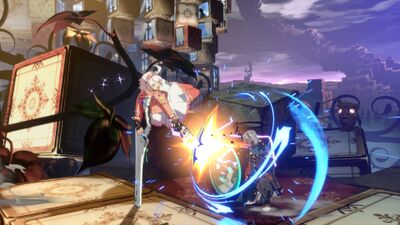Your primary pressure string at close-range is c.S > 2S > (5H or 2H) > 214S~P/K~H. This gives a lot of opportunities for frametraps, and ends with Chain Lollipop for huge corner carry, meter gain, and an easy mixup.
One of the most important choices is between 5H and 2H. Using 5H will always lose to a 6P attack, but covers huge range as a frametrap. Additionally if you're still within range this allows Here I Go! (214S) GuardAllStartup20Recovery16Advantage-2 to be a frametrap for easy pressure. By contrast, 2H is Throwable, and even after Fautless Defense will enable you to threaten Here I Go! at the cost of no longer being a true frametrap and losing to 6P abare. Consider that while both options can lose to abare, the opponent must allow the other to be a Counter Hit, netting huge reward even midscreen. Below is a quick reference table for comparison:
GuardAllStartup20Recovery16Advantage-2 to be a frametrap for easy pressure. By contrast, 2H is Throwable, and even after Fautless Defense will enable you to threaten Here I Go! at the cost of no longer being a true frametrap and losing to 6P abare. Consider that while both options can lose to abare, the opponent must allow the other to be a Counter Hit, netting huge reward even midscreen. Below is a quick reference table for comparison:
| 5H | 2H |
|---|---|
| Punished by 6P | Punished by Throw |
| Frametraps into 214S | 6P can interrupt 214S |
| Pushed out very far by Faultless Defense | Barely affected by Faultless Defense |
| -11 at far range | -4 at close range |
| Big midscreen Counter Hit | Big midscreen Counter Hit |
Here I Go! is an important pressure ender and reliant on staying close. If the opponent is pushing you out with Faultless Defense, using 2H will keep you in range, while cancelling from 2S can surprise an unsuspecting opponent with c.S > 2S > 214S~P/K~H at the risk of 6P and other strong punishes.
Despite the seemingly poor on-block frame data, Elphelt is built around Stagger Pressure. The opponent has to deal with a large number of potential frametraps, most often with 6P, and sometimes 5P and Throw. Staggering your offense allows easy whiff punishes on these while potentially closing the gap against Faultless Defense. This is easiest from c.S thanks to its advantage on block, but can occasionally be done from 2S/f.S and rarely even 5H.











